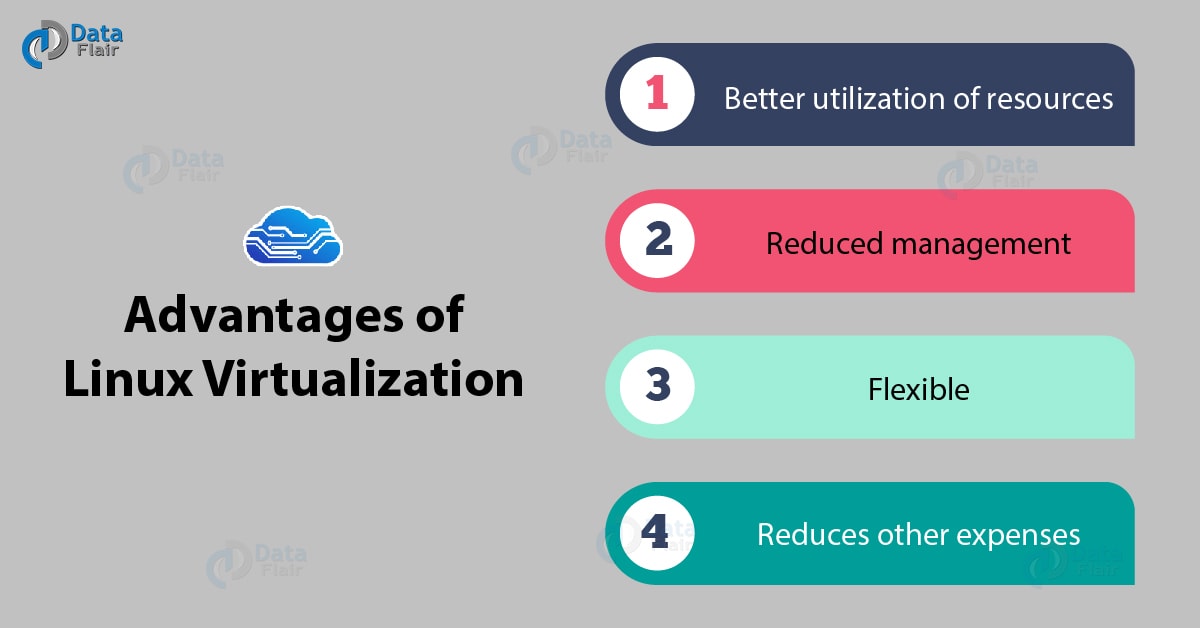4 Amazing Linux Virtualization Software and Advantages
Free AWS Course for AWS Certified Cloud Practitioner (CLF-C01) Start Now!!
Hope you enjoyed our last article Software Virtualization. Today, we will talk about Linux Virtualization. This Virtualization in Cloud Computing means running multiple virtual machines on a single physical computer which are operated by the Linux open-source operating system.
Here, we will learn top software and advantages of Linux Virtualization. Along with this, we will cover the different kinds of tasks by Parallels Virtuozzo Containers.
So, are you ready for Linux Virtualization Tutorial?
What is Linux Virtualization in Cloud Computing?
Linux virtualization is done by installing a virtual machine application on a computer system which can make multiple virtual machines based on the back-end system resources. It can use for isolating specific apps, programming code, operating system, for security, and performance testing.
In Linux virtualizations, the virtual eyes machine shares the hardware but runs independently of the Linux operating system. With the help of higher processing computers and flexible hardware, virtualization is more practical and flexible for most of the environment.
It maximizes the output and provides maximum performance by helping to save power and eliminating the use of hardware. The next virtualizations also allow to create and execute Mac OS X, Windows, and the other virtual machines which are powered by an operating system other than Linux.
Top Linux Virtualization Software
Let’s see some important Software of Linux Virtualization in Cloud Computing:
- VMware server
- XEN
- Parallels Virtuozzo Containers
i. VMware Server
VMware server makes it possible to partition a single physical server into many virtual servers are machines?. It works with Linux and many other which can use concurrently on the same hardware.
ii. XEN
This includes three Software and they are –
- Citrix XenServer
Citrix XenServer based on open source Xen hypervisor which delivers low overhead and near-native performance.
- Oracle VM
This is based on open source XEN hypervisor technology. The main benefit of Oracle VM is that it has a web browser-based management console and supports both Windows and Linux guests. It features fully tested and certified Oracle applications.
- Sun xVM
It is a product line from Sun Microsystems which addresses virtualizations technology based on the open source Xen under Solaris environment onx86-64 systems. It is a family of server and desktop virtualization technologies and solutions.
iii. Parallels Virtuozzo Containers
This product is an operating system level virtualization which designs for large-scale servers and data centres. It is a patented OS virtualizations solution.
It can create isolated partitions on a single physical server and operating system instance to use hardware, software, and data centre with maximum efficiency.
Tasks Performed by Parallels Virtuozzo Containers
- Management
Proper tools and templates use for automated, multi-container, and multi-server administration.
- Proper Partitioning
Providing a partition of the server into multiple can perform by Parallels Virtuozzo Containers with full server functionalities.
- Security
When a server is divided all the parts secure and fully functional.
In addition, a person can run multiple Linux distributions inside Parallels Virtuozzo Containers.
Advantages of Linux Virtualization
Following are some benefits of Linux Virtualization:
Let’s revise – Mobile Cloud Computing
i. Better utilization of resources
The overall efficiency of the system can increase bile Linux virtualizations as the physical CPU and memory shared. It eliminates the problem of buying a separate hardware can provide the benefits by boosting the productivity and configuring the new environment.
ii. Reduced Management
As the number of physical hardware servers is less so the time and the funds which are raised for the management will be less such as cooling and energy requirements.
iii. Flexible
Linux Virtualizations provide the flexibility to create a new environment with an existing physical box with the use of applications’ modified Xen virtualization implementations. It is compatible with the needs of customers and makes the customer more responsive to business needs.
iv. Reduces other expenses
The cost of licensing is a major factor. So, if the number of hardware is less the cost of licensing will be less. In Linux virtualizations, this major cost reduce as the number of hardware Alice and a single hardware can utilize virtually into any hardware.
As many logical environments support in the same physical box the customer will not require many licenses.
So, this was all about Linux Virtualization tutorial. Hope you liked our explanation.
Conclusion
As in Linux virtualizations, more virtual machines can be installed, executed, and maintained on the top of the Linux operating system the flexibility and compatibility are more which makes it user-friendly.
Here the consolidation of hardware and software takes place which allows Linux OS to be shared and divided across multiple virtual machines.
Furthermore, if you have any query/doubt, feel free to ask in the comment section.
Did you like our efforts? If Yes, please give DataFlair 5 Stars on Google


